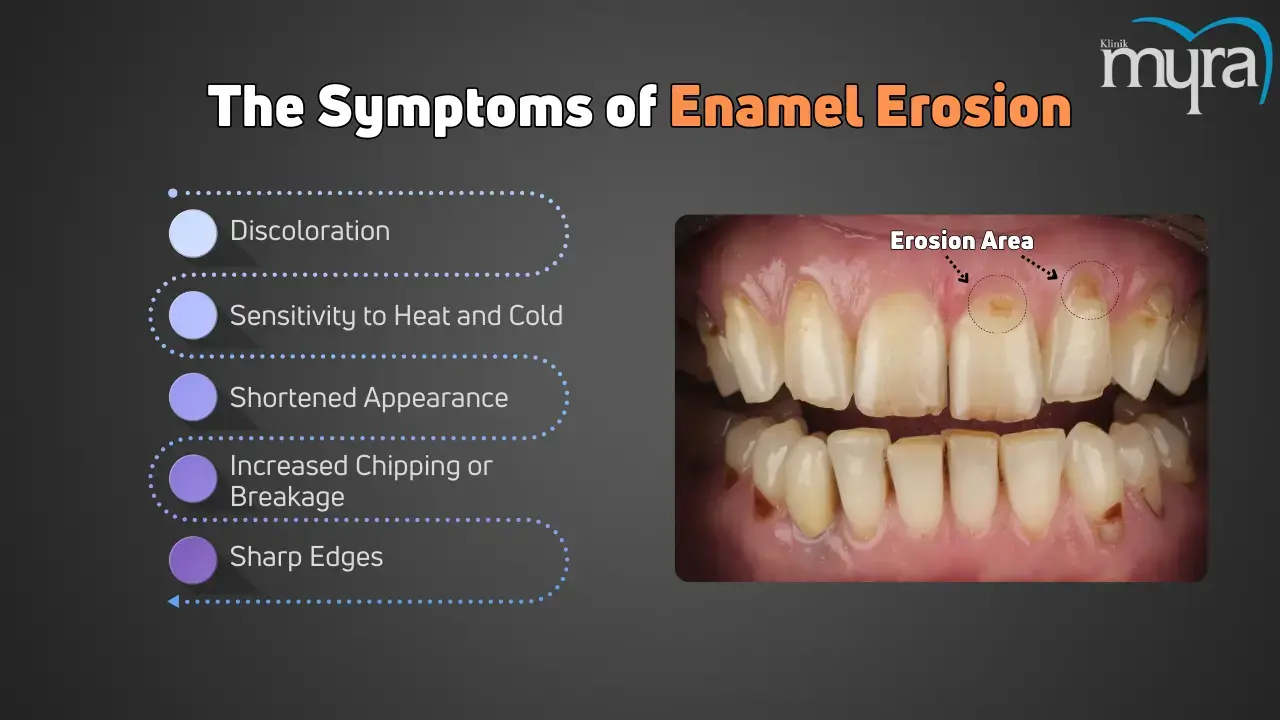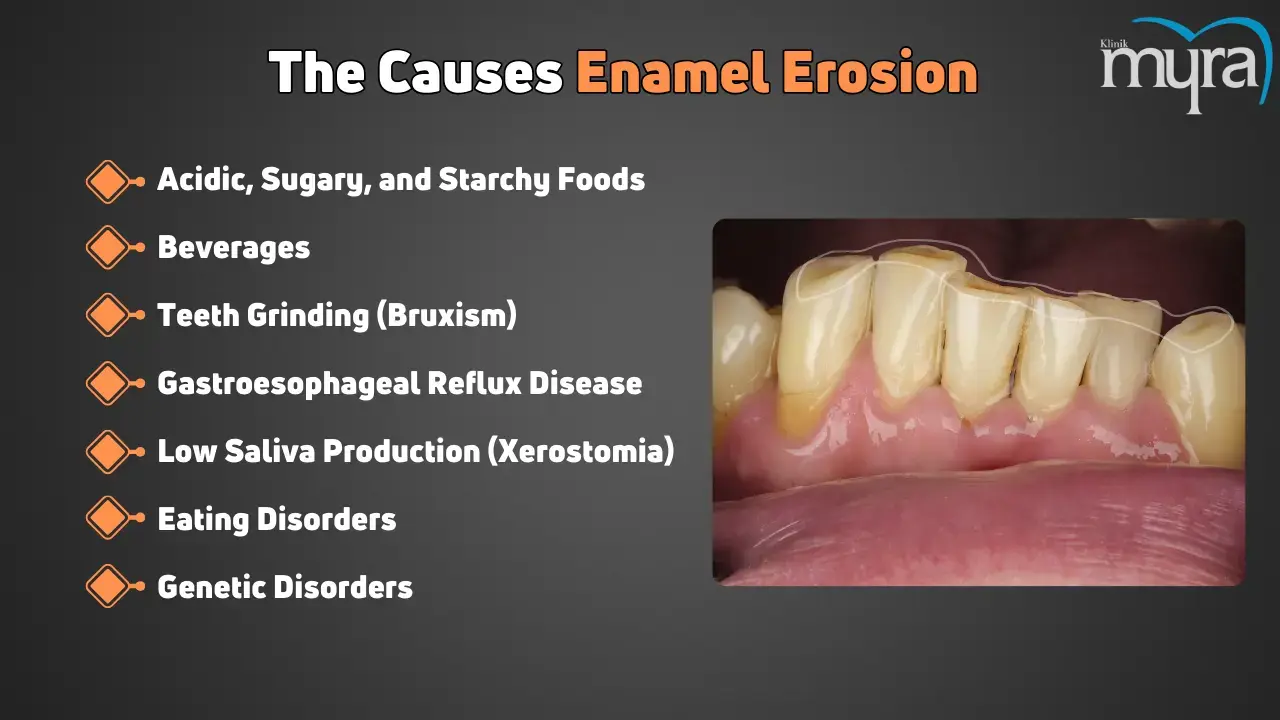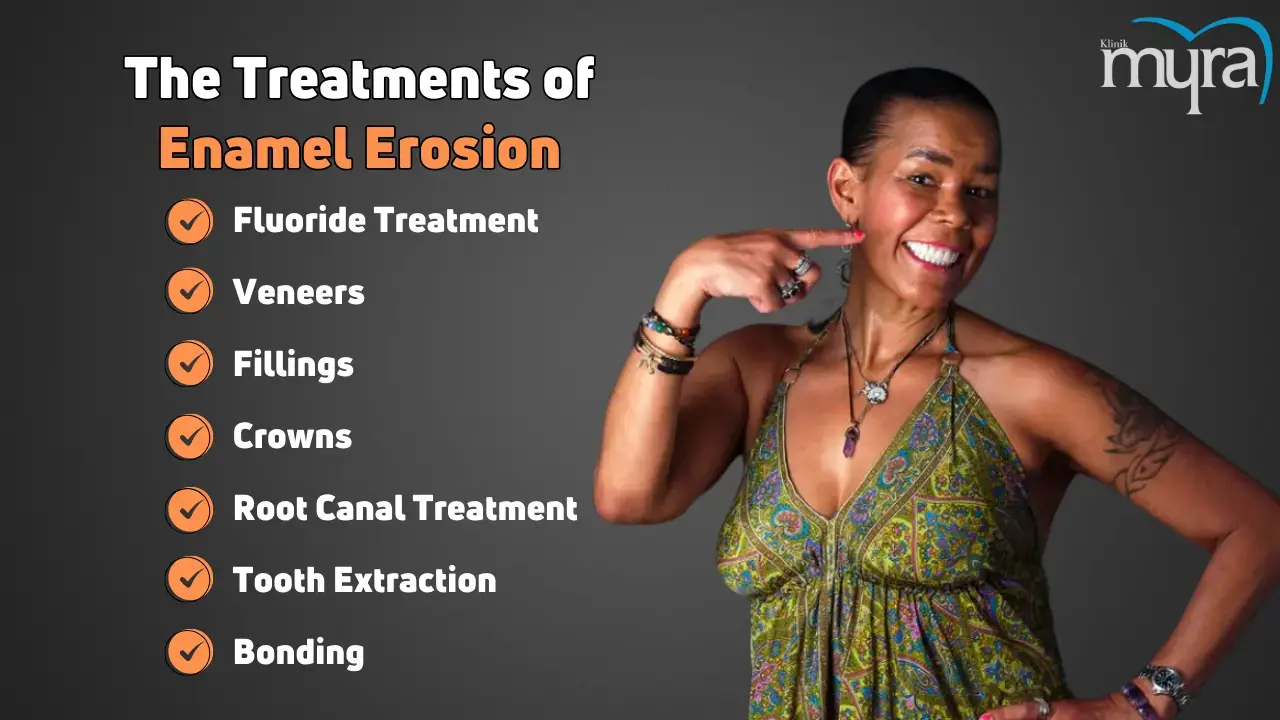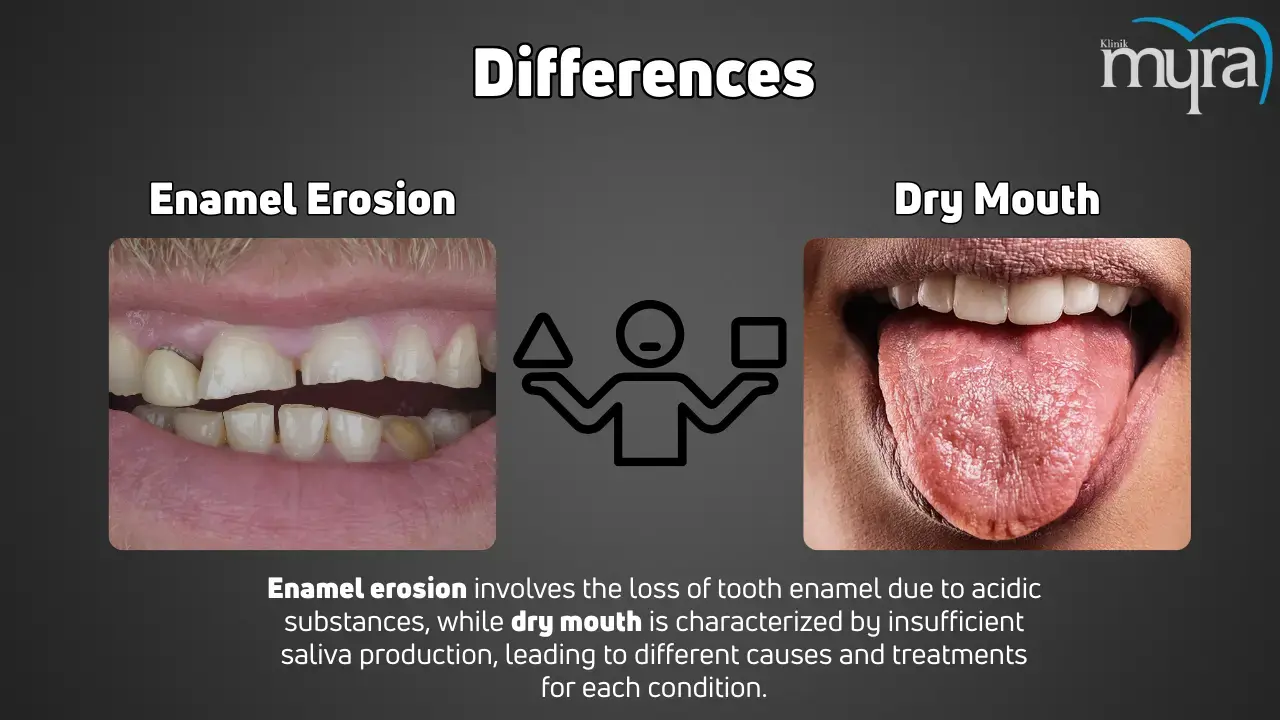Enamel erosion is the progressive loss of tooth enamel, the hard, protective outer layer designed to shield teeth from damage and decay. The types of enamel erosion are chemical erosion, attrition, abstraction, dietary erosion, and gastric erosion. Patients at risk must know enamel erosion symptoms, treatment, and causes to obtain preventive actions and seek professional help.
The symptoms of enamel erosion include discolouration, which is characterised by the yellowing or dulling of teeth as a result of the thinning of the enamel and the exposure of the underlying dentin. It is expected to experience increased sensitivity to heat, cold, or sweetness as the protective enamel fades away, allowing the stimuli to reach the nerves within the tooth. Teeth appear shorter when the enamel layer thins and more chipping or breaking occurs due to the weaker structure. The enamel wears down unevenly, resulting in jagged or irregular surfaces and teeth developing pointed edges.
Treatments for enamel erosion safeguard and revitalise the teeth that have been impacted. Fluoride treatments assist enamel reconstruction by attracting minerals such as calcium and phosphate, strengthening teeth, and preventing further erosion. The front surfaces of teeth are enhanced, and a protective barrier is provided by veneers, which are custom-made porcelain or composite resin casings. Crowns cover teeth that are badly damaged and provide long-term protection, whereas fillings repair small cavities or regions of mild erosion. Root canal treatment is required if the tooth's inner tissue is exposed due to enamel loss. The last resort is tooth extraction when the enamel deterioration is severe and irreversible. The tooth's appearance and functionality are restored through dental bonding, which entails the application of a tooth-coloured resin.
Dietary behaviors, medical conditions, and mechanical wear cause enamel erosion. Enamel wear results from consuming acidic, sugary, and starchy foods, as these foods directly contain acids or digest into sugars that stimulate acid production by oral microbes. Acidic beverages, including citrus juices and sodas, erode enamel. Repetitive friction mechanically wears down the enamel in bruxism or teeth grinding. Enamel disintegration is expedited by chronic acid reflux (GERD), which exposes teeth to corrosive stomach acids. The mouth's capacity to neutralize acids is diminished by low saliva production (xerostomia), which increases erosion. Eating disorders, such as bulimia, expose teeth to gastric acids through frequent vomiting, while genetic disorders, such as amelogenesis imperfecta and enamel hypoplasia, result in enamel that is more susceptible to erosion.
“The research Influence of Energy Drinks on Enamel Erosion: In Vitro Study Using Different Assessment Techniques” by Silva et al. demonstrated that all tested energy drinks caused significant enamel erosion, with TNT Energy Drink® causing the most damage. “Effect of Different Citrus Sweets on the Development of Enamel Erosion In Vitro,” authored by Souza et al., found that various citrus sweets, including Fini Diet® and Fini Regaliz Tubs®, have a high erosive potential on bovine enamel, similar to citric acid solutions.
“Protective Effect of Fluorides on Erosion and Erosion/Abrasion in Enamel: A Systematic Review and Meta-Analysis of Randomized In Situ Trials” by Zanatta et al., concluded that fluoride toothpastes, especially the ones containing NaF and Sn/associations, significantly reduce enamel erosion and wear, with stannous fluorides providing the best protection. “Calcium Phosphate Nanoclusters for the Repair of Tooth Enamel Erosion” by Wang et al. showed that calcium phosphate nanoclusters effectively restored the hardness of enamel damaged by phosphoric acid, indicating their potential as a treatment for early-stage tooth erosion.

What are the Types of Enamel Erosion?
The types of enamel erosion are listed below.
- Chemical Erosion: Chemical erosion occurs when acids chemically degrade teeth. The process gradually weakens teeth and results in irreversible enamel loss. Common causes include regurgitated stomach acids and dietary acids.
- Attrition: Attrition occurs when friction occurs between teeth. Clenching or Teeth grinding as known bruxism commonly causes the condition, which erodes tooth enamel. Enamel erosion renders the teeth more vulnerable to fractures and decay.
- Abfraction: Abfraction results from excessive stress and pressure, causing the loss of dental enamel. The condition manifests near the gumline as discoloured V-shaped notches.
- Dietary Erosion: Dietary erosion occurs from ingesting acidic foods and beverages. The acids present in the diet cause the loss of tooth structure. Highly acidic foods such as citrus fruits, carbonated sodas, sugary foods, and beverages lead to dietary erosion.
- Gastric Erosion: Gastric erosion results from the loss of dental enamel caused by stomach acids. Acid reflux, a typical example, involves the backflow of stomach acids into the oral cavity. Excessive vomiting causes gastric erosion.
What are the Symptoms of Enamel Erosion?
The symptoms of enamel erosion are listed below.
- Discoloration: Teeth undergo colour changes due to enamel erosion, resulting in a yellowish or lacklustre appearance. Discolouration ensues as the protective enamel layer diminishes, revealing the inherently more yellow dentin beneath.
- Sensitivity to Heat and Cold: Teeth develop sensitivity to hot, cold, or sweet stimuli when enamel erosion reveals the dentin layer. Dentin is more permeable and permits external stimuli to access the nerves within the tooth, leading to discomfort.
- Shortened Appearance: Enamel erosion causes teeth to appear shorter as the outer enamel layer diminishes. The erosion reveals less of the tooth's length, altering its visual proportions.
- Increased Chipping or Breakage: Teeth become more susceptible to chipping or breaking as enamel erosion compromises their protective layer. Teeth are more vulnerable to physical harm when enamel is absent since it protects teeth from pressure or impact.
- Sharp Edges: Enamel erosion leads to sharp edges on teeth. It occurs as the outer enamel layer wears down unevenly, exposing underlying areas with jagged edges or irregular surfaces.

What are the Causes Enamel Erosion?
The causes of enamel erosion are listed below.
- Acidic, Sugary, and Starchy Foods: Enamel erosion results from consuming acidic foods like citrus fruits and berries, saccharine foods like ice cream and caramel, and starchy foods like white bread. These food products inherently contain acids or decompose into sugars that facilitate acid production by oral bacteria, culminating in enamel's gradual degradation and erosion.
- Beverages: Acidic beverages such as fruit juices and sodas containing citric and phosphoric acids instigate enamel erosion. The acids directly corrode enamel and augment susceptibility to decay over time.
- Teeth Grinding (Bruxism): Bruxism (teeth grinding) mechanically wears down tooth enamel through repetitive friction. Bruxism weakens the enamel and makes teeth more vulnerable to erosion and damage.
- Gastroesophageal Reflux Disease (GERD): Acid reflux exposes teeth to highly corrosive stomach acids that accelerate enamel breakdown over time. The condition significantly increases the risk of enamel erosion.
- Low Saliva Production (Xerostomia): Conditions inducing low saliva production, such as diabetes or adverse effects from medications like antihistamines and aspirin, diminish the mouth's capacity to neutralise acids. It permits acids from foods and beverages to persist in the oral cavity longer, exacerbating enamel erosion.
- Eating Disorders: Eating disorders such as bulimia involve frequent vomiting, and exposing teeth to stomach acids that are highly damaging to tooth enamel. The exposure leads to severe erosion over time.
- Genetic Disorders: Genetic conditions such as amelogenesis imperfecta and enamel hypoplasia affect enamel formation during tooth development. Patients with genetic disorders have weaker enamel, more susceptible to erosion from standard dietary and environmental factors.

What are the Treatments of Enamel Erosion?
The treatments for enamel erosion are listed below,
- Fluoride Treatment: Fluoride applications rebuild enamel by attracting minerals such as calcium and phosphate, strengthening teeth and making them more resistant to acid attacks, preventing further erosion.
- Veneers: Veneers are custom-made porcelain or composite resin shells that cover teeth' front surfaces. Teeth veneers improve the appearance of eroded teeth and deliver a protective barrier against further damage.
- Fillings: Dental fillings repair small cavities or areas of minor enamel erosion. The treatment restores the tooth's shape and function, preventing decay from progressing into the tooth structure.
- Crowns: Crowns are caps placed over severely impaired or deteriorated teeth. The procedure strengthens and guards the entire tooth structure while restoring its shape and appearance, providing long-term protection against erosion.
- Root Canal Treatment: Root canal therapy is required when enamel loss reveals the tooth's inner pulp. The root canal procedure removes damaged tissue, disinfects the tooth, and seals it to prevent further decay and preserve its function.
- Tooth Extraction: Teeth extraction is the last option to stop infection and preserve dental health when enamel degradation is severe and irreversible.
- Bonding: Dental bonding involves applying a tooth-coloured resin to eroded or damaged teeth, which is hardened with a special light. The procedure restores the tooth's impression and function while providing some protection against further erosion.

Can Enamel Erosion Be Treated At Home?
No, enamel erosion cannot be treated at home. Enamel erosion involves the gradual breakdown of tooth enamel, which is irreversible once the enamel is lost. Only preventive measures are available at home, and professionals obtain treatments. Adherence to proper oral hygiene practices is the most effective preventive measure.
Plaque and bacteria contributing to enamel erosion are removed through regular flossing and cleansing with fluoride toothpaste. Fluoride, a mineral recognised for fortifying teeth, is advantageous for teeth protection. Fluoride mouthwash is incorporated into a daily oral care regimen to remineralise compromised enamel and enhance teeth's resistance to acid attacks.
Another critical approach is to restrict the intake of acidic foods and beverages. Enamel is eroded by acidic foods, such as citrus fruits, drinks, and vinegary foods, over time. Patients with enamel erosion reduce the exposure of their teeth to acids by minimising their intake or rinsing with water after consuming them. Consuming sugar-free gum increases saliva production, which aids in neutralising acids and remineralising enamel.
Advanced instances require professional dental care, even though these preventive methods at home are partially effective in treating enamel loss. Dentists protect and restore teeth with dental bonding, fluoride treatments, crowns, or veneers in severe situations. Patients must undergo routine dental examinations to promptly address any emergent dental problem and monitor the progression of enamel erosion. Combining professional dental care with excellent oral hygiene habits is the most effective method of managing and mitigating enamel erosion.
What are the Researches about Enamel Erosion?
The researches about enamel erosion are about understanding the causes, effects, and treatments of enamel erosion, focusing on the impact of acidic foods and drinks, fluoride protection, and calcium phosphate nanocluster repair techniques.
“Influence of Energy Drinks on Enamel Erosion: In Vitro Study Using Different Assessment Techniques” employed an in vitro erosion model to assess the erosive potential of energy beverages on dental enamel. The positive control consisted of Coca-Cola®, Monster Energy®, Red Bull®, and TNT Energy Drink®. Thirty-eight blocks of human enamel were divided into four groups, each exposed to a distinct beverage. The study examined the beverages' pH, titratable acidity, and buffering capacity and assessed enamel erosion by surface microhardness, profilometry, and mineral loss analysis. The results demonstrated that enamel was eroded by all energy drinks, with TNT Energy Drink® causing the most significant harm. Drinkers must exercise caution when consuming acidic beverages, as the study stresses their high erosive potential.
“Effect of Different Citrus Sweets on the Development of Enamel Erosion In Vitro” was conducted to assess the erosive potential of various citrus treats on bovine enamel. Ninety bovine crowns were produced and subjected to erosive challenges that involved the dissolution of multiple sweets in water. The erosive potential of all citrus treats tested was determined to be high by the study, which employed contact profilometry to measure enamel wear. Fini Diet® and Fini Regaliz Tubs® were among the most erosive, comparable to citric acid solutions. The results emphasise the critical role of acidic candies in developing erosive toothwear and the necessity of regulating their consumption to safeguard enamel.
“Protective Effect of Fluorides on Erosion and Erosion/Abrasion in Enamel: A Systematic Review and Meta-Analysis of Randomized In Situ Trials” evaluated the efficacy of a variety of fluoride compounds and vehicles in preventing enamel erosion and erosive tooth attrition. The review encompassed 32 studies that compared fluoride treatments to control groups, water or placebo. The results showed that fluoride toothpastes, particularly the ones containing NaF and Sn/associations, substantially reduced enamel loss in response to erosive/abrasive challenges. Stannous fluoride solutions were effective as mouth rinses, whereas NaF rinses did not exhibit a significant effect. The research indicates that fluoride products mitigate enamel loss, with stannous fluorides providing the most comprehensive protection. The degree of certainty is inconsistent.
“Calcium Phosphate Nanoclusters for the Repair of Tooth Enamel Erosion” is a groundbreaking study investigating the potential of calcium phosphate nanoclusters (CaP NCs) to restore enamel erosion. The researchers synthesized CaP NCs and applied them to enamel that had been harmed by phosphoric acid etching. The hardness of treated enamel increased to levels comparable to normal enamel, as evidenced by microhardness testing, suggesting the repair was effective. The study illustrates the potential of CaP NCs as a prospective treatment for early-stage tooth erosion, providing a tunable and practical approach to enamel repair.
What are the Differences between Enamel Erosion and Dry Mouth?
The differences between enamel erosion and dry mouth are significant in their causes, effects, and treatments. The loss of tooth enamel, the firm, the protective outer layer of the teeth, is the hallmark of enamel erosion. The condition is characterised by sensitivity, discolouration, and an elevated risk of developing cavities. Frequent consumption of acidic foods and beverages, GERD (Gastroesophageal Reflux Disease), and reduced saliva flow are the causes. Dietary modifications, professional fluoride treatments to fortify enamel, excellent oral hygiene with a soft-bristled toothbrush and fluoride toothpaste, and the management of GERD are the primary treatments.
Dry mouth (xerostomia) is insufficient saliva production, resulting in difficulty swallowing and speaking and an elevated risk of decay and periodontal disease. The causes are dehydration, radiation therapy, Sjögren's syndrome, diabetes, Parkinson's disease, and adverse effects of medications. Treatments aim to enhance saliva flow in a dry mouth by employing saliva substitutes, adjusting medications, increasing water consumption, and maintaining good oral hygiene.
Enamel erosion and dry mouth carry a significant risk of discomfort and consequences, including increased sensitivity and cavities, if left untreated. The significance of a balanced diet and regular dental check-ups for early detection and treatment is emphasised by the necessity of good oral hygiene in managing the conditions.






